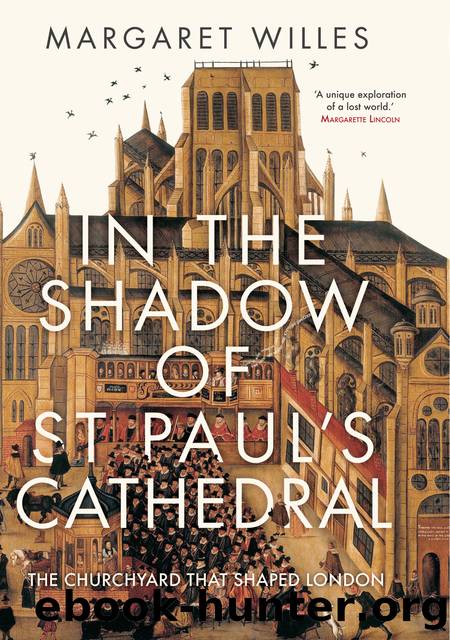In the Shadow of St. Paul's Cathedral: The Churchyard That Shaped London by Margaret Willes

Author:Margaret Willes [Willes, Margaret]
Language: eng
Format: epub
Tags: History, Europe, Great Britain, General, Social History, Architecture, Buildings, Religious
ISBN: 9780300265675
Google: 8eVfEAAAQBAJ
Publisher: YaleUP
Published: 2022-03-22T20:27:20+00:00
11. Sutton Nichollsâs engraving of 1695 showing Wrenâs new cathedral under construction, with the east end almost complete, but with screens to keep the curious away from the middle part of the building.
Henry Compton, Bishop of London, preached from the new pulpit that Gibbons had carved. His sermon, appropriate for the occasion, was based on Psalm 122, âI was glad when they said unto me: Let us go into the house of the Lordâ. He intended that the cathedral should unite the nation, reviving the concept of anniversary services and sermons that had been such a feature of Elizabethan and early Stuart times. But now these were to take place inside the cathedral, rather than at the pulpit of Paulâs Cross in the Churchyard. One such anniversary was the double deliverance on 5 November, the discovery of the Gunpowder Plot in 1605 and the arrival, thanks to the Protestant wind, of William of Orange to rid the nation of its Catholic King, James II, in 1688.
John Evelyn wanted also to attend the afternoon service, but âthe presse of people was so greate that I durst not ventureâ.23 Instead, he listened to a sermon in St Martin Ludgate, although he did mingle with the crowds in the Churchyard. He was delighted to learn from some of Wrenâs workmen that they had been making use of his translation of Fréartâs Parallèle de LâArchitecture Antique et de la Moderne. So impressed was he by the new St Paulâs that he resolved to write a preface to a new edition of the book. In his characteristically flowery style, he paid tribute to Wren, declaring:
the great Esteem I have ever had of Your Virtues and Accomplishments, not only in the Art of Building, but throâ all the learned Cycle of the most Usefull Knowledge and Abstruser Sciences, as well as of the most Polite and Shining.â.â.; if the whole Art of Building were lost, it might be Recoverâd and found again in St Paulâs, the Historical Pillar.
He also declared rather more succinctly in a letter to Wren that âthe Phoenix is Risenâ.24
But in 1697 the cathedral was still lacking its crowning feature. Wren had from the very beginning intended that the new St Paulâs should have a dome at the crossing. Indeed, back in 1666, with John Evelynâs support, he had argued for a dome for Old St Paulâs. It was going to be this part of the cathedral that departed radically from the Warrant Design of 1675. Instead of the rather modest dome topped by a tall spire, Wren was planning a much more monumental structure to rise in magnificence over Londonâs skyline. However, such a structure would be too lofty when seen from the inside. His solution was to build a brick cone in support of the lantern that was to be surmounted by a ball and cross. Over this cone he built the outer dome, 60 feet taller.
Wren was a young man in his early thirties when he began to work on St Paulâs.
Download
This site does not store any files on its server. We only index and link to content provided by other sites. Please contact the content providers to delete copyright contents if any and email us, we'll remove relevant links or contents immediately.
| Landmarks & Monuments | Religious Buildings |
| Residential |
Kathy Andrews Collection by Kathy Andrews(11686)
The remains of the day by Kazuo Ishiguro(8754)
Paper Towns by Green John(5029)
Spare by Prince Harry The Duke of Sussex(5002)
The Body: A Guide for Occupants by Bill Bryson(4892)
Industrial Automation from Scratch: A hands-on guide to using sensors, actuators, PLCs, HMIs, and SCADA to automate industrial processes by Olushola Akande(4854)
Machine Learning at Scale with H2O by Gregory Keys | David Whiting(3980)
Be in a Treehouse by Pete Nelson(3881)
Harry Potter and the Goblet Of Fire by J.K. Rowling(3746)
Never by Ken Follett(3712)
Goodbye Paradise(3672)
Into Thin Air by Jon Krakauer(3268)
The Remains of the Day by Kazuo Ishiguro(3259)
The Cellar by Natasha Preston(3225)
The Genius of Japanese Carpentry by Azby Brown(3197)
Fairy Tale by Stephen King(3163)
120 Days of Sodom by Marquis de Sade(3123)
Drawing Shortcuts: Developing Quick Drawing Skills Using Today's Technology by Leggitt Jim(2965)
The Man Who Died Twice by Richard Osman(2962)
